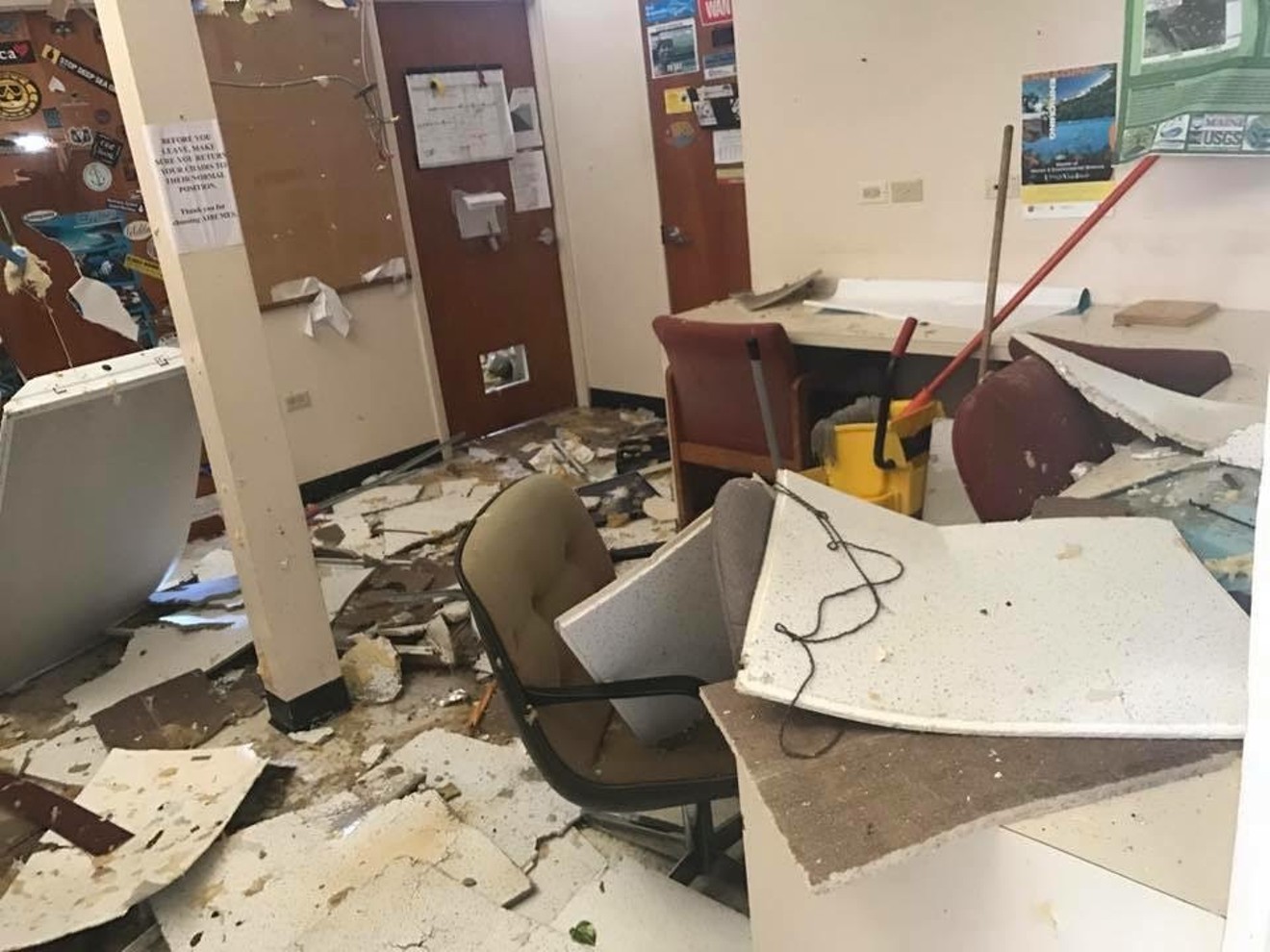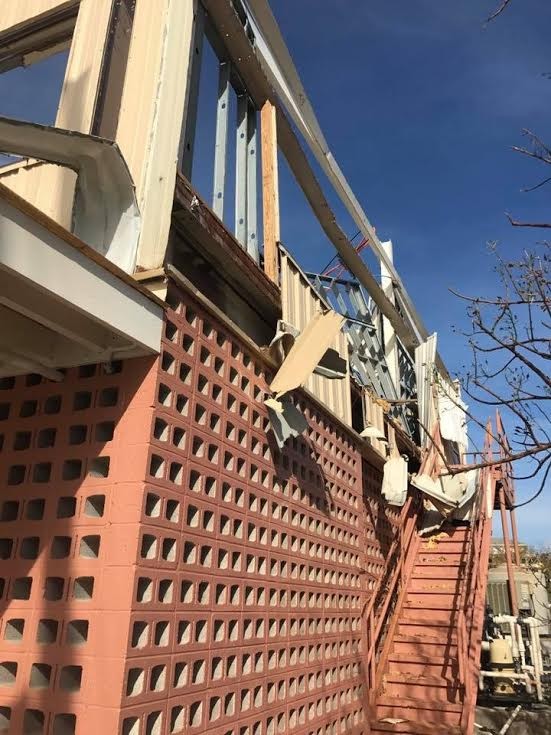Two weeks ago, Irma, a catastrophic Atlantic hurricane, killed 38 people and destroyed thousands of homes in the Caribbean before turning toward South Florida. Among the most victimized was Saint Thomas, a 32-square-mile island located 110 miles east of Puerto Rico. As one of 51,000 Saint
So far, Ramseyer has connected with about a dozen students still on the island, most of whom have responded that the situation there is hopeless. Even though Irma had
"I feel helpless," she says. "I wanted to be back there even though I knew it wouldn't be helpful or productive. It's not like I can hold someone’s roof on with my hands."
She recalls the wasteland she saw in the hours after Irma passed. "It was like a wildfire came through — the wind stripped the trees of their bark and leaves, leaving a reddish-brown color." Without the foliage, she could see houses she hadn't known were there. "I never knew we had so many neighbors," she murmurs.
Born in Gainesville, Virginia, Ramseyer, a smiley, golden-locked diver, grew up a passionate advocate of marine conservation. As a teenager, she organized campaigns against overfishing and fracking. In her college years, Ramseyer interned as a fish caretaker for the Smithsonian Institution. Eventually, in 2015, she moved to Saint Thomas to attend the University of the Virgin Islands. There, she studied turtles, tagged stingrays and dove around the coral reefs, doing measurements on various ecosystems. Though well-acquainted with Caribbean climate systems, she could never
"When I first heard about [Irma], everyone downplayed it," Ramseyer says, "Even my landlord said, 'Oh, it's just a Category 3.'" Having experienced many tornados in Virginia, she shrugged off Irma as nothing more than a "wet tornado" and made only minor preparations. She boarded up the windows on one side of her apartment, packed a couple days' worth of canned foods and water, and filled a small portable cooler with ice chunks. A few days later, it was the eve of Irma. That afternoon, her neighbor Jennifer sent her a text: "It's a Category 5."
Petrified, Ramseyer fled to Jennifer's apartment. The two — surrounded by their three dogs, bottles of red wine, and a tiki torch — hunkered down in a windowless bathroom. For hours, they heard nothing but the ominous whistle of the wind. But then they began to hear the snap of tree branches outside. The sound was unmistakable: The rain had come. Soon enough, water began creeping through the cracks of the hurricane shutters, the window panels, and the roof, submerging Jennifer's living room in five inches of water, sand, and mud. Every so often, Ramseyer's ears popped, so she ran to the front door and opened it, hoping the ventilation would relieve some of the built-up air pressure.
By the time the storm was over, a concrete wall had fallen onto Ramseyer's car and her apartment was a foot deep in floodwater. "I was fortunate," she says: "I had damages and flooding, but a lot of people in Saint Thomas lost their roofs, their homes, and their belongings." One of her neighbors even broke a rib trying to reaffix shutters that had blown off during the storm.
Afterward, people struggled to leave while the streets were filled with tree debris, refuse, and downed utility poles. In an attempt to help, many emerged from their homes with machetes and chainsaws, hacking away at road blockages. At one intersection, a man had even used tree branches to prop up a fallen power line so cars could pass beneath it.
Soon enough, the local government issued an evening curfew to allow for road maintenance crews to clear the streets. However, many civilians ignored the curfew and drove out in search of places with either power or cell-phone service so they could check in with loved ones. "Fifteen minutes away from my house, there was this place with dirty cars, and a ton of people were outside talking on their cell phones, trying to tell their friends and family they were OK." Meanwhile, local radio stations continued blasting music instead of storm-relief updates. "We wanted to know what was going to happen with Hurricane Jose," Ramseyer says. "That was our next immediate threat."
Over the next few days, Jose spared Saint Thomas. With relatively clear skies, dozens of helicopters, military aircraft, and one commercial airliner passed through the airport near Ramseyer's apartment. Mostly, she says, they were evacuating injured people to Puerto Rico and Saint Croix.
As for those who stayed behind, little relief was provided and power wasn't restored. "We heard FEMA was coming with food and water, but I never saw them," Ramseyer says. "This one day, I saw people waiting for ice, but then policemen and armed guards sent them away, saying there was no ice coming." She was even warned not to enter the city due to reports of looting. "People were [
Worried, Ramseyer's parents told her to return home to Virginia, but each flight through Saint Thomas was delayed and then canceled. Packing a duffel bag with her dog's medicine, her master's thesis, and her notebooks, she hopped onto a ferry from Saint Thomas to Saint Croix, took a plane to Puerto Rico, and then transferred to a flight to Virginia. While she was in transit, she heard the island was about to be hit by Maria.
After arriving home, Ramseyer took on the responsibility of checking in with the dozen or so students still on the island. Through brief texts, her classmates told her that Irma had done the bulk of the damage, taking down large trees and structures. But because the government had failed to clear the debris (hear this, Miami?), they knew heaps of trash, shattered wood, and mangled power lines would fly around during Maria. By Wednesday, their worst fears were confirmed. Fierce winds and torrential rain raked the weary island, striking down many of the territory's remaining trees and buildings.
About 1,400 miles away in Virginia, Ramseyer helplessly watched the news as dangerous mudslides overtook Saint Thomas' roadways, making them impassable. By the time the storm ended, her classmates all texted the same horrifying news: The island was inundated with three-foot-deep pools of stagnant floodwater. "Standing water attracts mosquitoes, so everyone was worried about one thing," Ramseyer says: "Zika."
Unable to physically help, Ramseyer offered to make phone calls for her fellow Saint Thomians and notify their relatives of their status. It's been challenging, she says, because many cell towers were downed after Irma, and even more fell after Maria.
It's too soon to tell when or if Ramseyer will return. "The power is still out and the university is still damaged. I'm supposed to graduate in December, but now they might push it back and just conclude the semester."
She says graduating isn't the most pressing thing on her mind right now. Because many friends are still on the island, Ramseyer worries about their safety and recovery. "I've been watching the news, but it's always footage about Puerto Rico and Saint Croix," she says. "Places like Saint Thomas and Saint John aren't getting the attention they deserve, which is frustrating because that's our home. Maybe if we were a state instead of a territory, it would be different."
Thus far, many people in Saint Thomas have already created support forums online, such as online signups for people with vessels available for evacuations and Facebook pages for missing persons or pets. Even so, Ramseyer anticipates it won't be enough. "Our government in the Virgin Islands is in debt; they're not equipped to handle the recovery of the islands," she says. "We were relying on Puerto Rico to send supplies, but now they're also totaled after Maria."
It will take the combined effort of multiple agencies and organizations to rebuild. Even so, she says she's hopeful: "I don't want my islands to be left behind forever."
To contribute to relief efforts, visit the island's recovery site.















